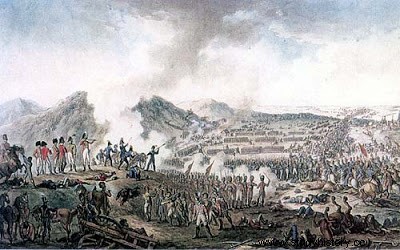
The Battle of Talavera, or Talavera de la Reina, is a bloody battle of Napoleon's campaign in Spain, which took place on July 27 and 28, 1809 in Talavera de la Reina, in the province of Toledo.
Campaign before the battle
After chasing Marshal Soult's French army from Portugal, General Arthur Wellesley's 20,000 men advanced into Spain to join up with General Cuesta's 33,000 Spaniards. They go up the Tagus Valley to Talavera de la Reina, 115 km southwest of Madrid. There, they met 50,000 French people divided into two army corps, that of Marshal Victor and that of General Sébastiani, under the command of the King of Spain, Joseph Bonaparte, assisted by Marshal Jourdan, his chief of staff. The combined Allied forces have an opportunity to defeat Victor's corps in the vanguard at Talavera, but Cuesta stubbornly refuses to fight on a Sunday, giving the French an opportunity to escape.
Procedure
The following day, July 26, having missed his best chance of victory, Cuesta launched his army after Victor, losing the clash with the French army, now led by Joseph Bonaparte, which had received reinforcements. The Spaniards beat a hasty retreat. Several British battalions are needed to cover them. Wellesley is almost captured by the French cavalry. At night, a patrol of French dragoons haunts the surroundings of the Spanish infantry camp. Ten thousand of them open fire simultaneously in one of the largest volleys fired during the Napoleonic wars. Panicked by their own fire, the Spaniards fled, playing virtually no part in the next day's battle.
The French crossed the Alberche at 3 p.m. on July 27. At 5 p.m., they attacked the Spanish right and the British left. A hill is taken, lost and retaken until the British hold it firmly. At dawn on July 28, the French attacked them again in order to retake the hill, but were repulsed. The cannonade continued until noon, when a two-hour truce was declared. At 2 p.m. heavy fire started as a prelude to a few skirmishes between infantry and cavalry. Around 5:30 p.m. to 6 p.m., a major engagement pushes back the French. The cannonade continues into the night. At dawn the following day, the French withdrew, leaving their wounded and two artillery brigades on the battlefield.
Review
British forces suffered the most in this hard-fought battle. They lost 6,200 men, while the Spaniards only lost a thousand. The French count 7,390 dead or wounded. Many of the wounded on both sides were burned to death when the dry grass caught fire.
In order to avoid an immediate confrontation with the advancing army of Marshal Soult, Arthur Wellesley retreated to Lisbon, leaving several thousand wounded under the protection of Cuesta. The Spaniard abandons them soon after. They are recovered by the French. This fact damaged the confidence between the British and the Spaniards for the rest of the conflict.
Although the Spaniards had pledged to provide food to their "allies" when they entered Spain, they not only did not keep their word, but threatened to pillage any town that sold them provisions. The British, forced to continue their retreat to Portugal, never trusted them again. From then on, the Kingdom of Portugal became the main ally of Great Britain.
After this battle Arthur Wellesley was made Viscount Wellington of Talavera.
